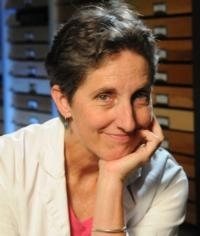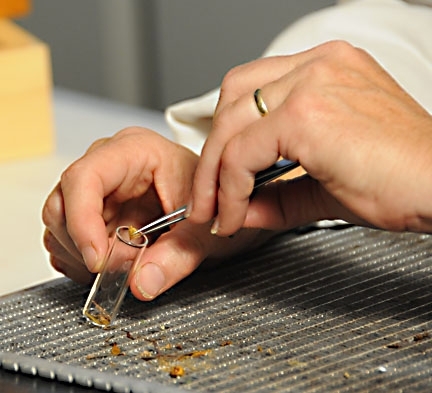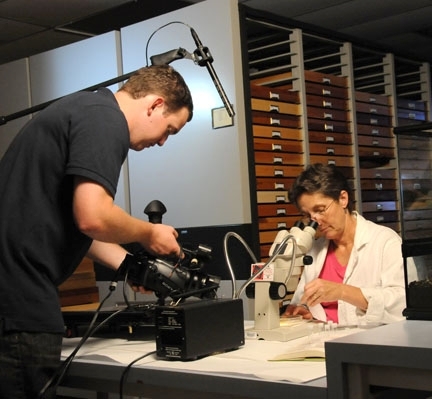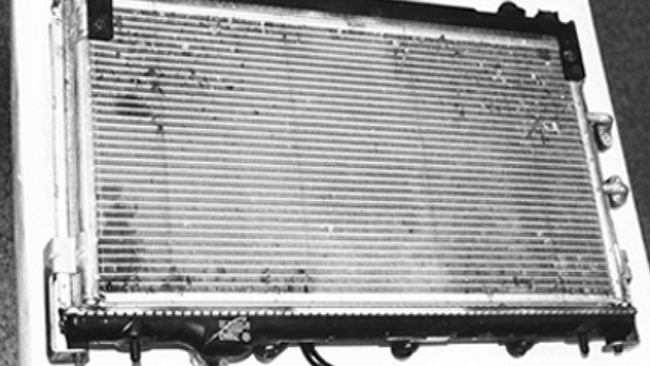- Author: Kathy Keatley Garvey

They wanted museum Director Lynn Kimsey, a professor of entomology, to identify the insects and their geographical home for an upcoming mass murder trial.
"I saw it as a puzzle to be solved," Kimsey said of the car parts embedded with several hundred insects. "I've never heard of anyone doing this."
Prosecutors from Kern County were alleging that Vincent Brothers, a former vice principal, drove a rented 2003 blue Dodge Neon from Ohio to California, where he killed five members of his family. The defense argued that the car had never left the Ohio area.
The Kern County Superior Court trial began in Bakersfield on Feb. 22 and ended May 15, with the jury convicting the 44-year-old Brothers of five counts of first-degree murder in the July 2003 shooting and stabbing deaths of his estranged wife, three children and mother-in-law. On May 29, the jury recommended the death sentence. Formal sentencing is scheduled for August.

"From the prosecution's point of view, half of the battle is being able to have witnesses knowledgeable in their field and the ability to explain that knowledge," Green said, noting that Kimsey is not only an expert in her field but a teacher.
"She taught me about the insects so I could understand the field and feel familiar enough to cross-examine their (defense) witnesses," Green added. "Her help was invaluable."
Kimsey described the experience as "interesting but terrifying."
"I didn't know anything about the court case," she added. "I couldn't even identify the defendant when I entered the courtroom."
In April 2004, Bakersfield police had arrested Brothers on suspicion of committing the murders. Brothers had been an employee of the Bakersfield City School District since 1989, and vice principal of Fremont Elementary School since 1996.
Brothers said he was in Columbus, Ohio, at the time of the murders. But the prosecution successfully argued that he caught a flight from California to Ohio, rented a car, and then drove to Bakersfield to kill his family.
"The insect evidence corroborated with the mileage on the vehicle, which had to have been driven west," Green said in the recent telephone interview.

The grasshopper is found in the Great Plains and the eastern slope of the Rockies. The paper wasp's territory is west of the 100th meridian, with California as "its center of abundance," Kimsey pointed out during the trial. In addition, she said that the two true bugs are also found only in the West: "Both are found in Southern California, Arizona and Utah."
She recalled that when she and senior museum scientist Steve Heydon picked off the insects from the car parts — it took them seven or eight hours, "We found no butterflies — no painted ladies, no sulphur butterflies. That indicated to us that the car wasn't driven during the day, but at night.
"The insects we found were consistent with two major routes to get to California from the East," said Kimsey, adding that court testimony revealed "4,500 unaccounted-for miles" on the rental car.
During her five-hour testimony, illustrated with a PowerPoint presentation, the UC Davis entomologist showed the distribution of the insects on a U.S. map, and compared insect photos from the car parts with specimens from the Bohart Museum.
Kimsey identified the large grasshopper by its leg, comparing the size, coloration and markings to a specimen at the museum. She testified that the hind legs of the grasshopper "help us identify" the species. The size of the large leg (red with black markings) indicated that the grasshopper measured "close to two inches long."
"The jury seemed very interested in what I had to say," Kimsey said.
Following her testimony, the defense called four entomologists to counter her evidence — three from Purdue University and one from the University of Illinois at Urbana-Champaign.
"The defense tried to make a case that insects are easily distributed," Kimsey said. They also questioned her expertise in diagnostics, systematics, field work and publications.
But Green, the prosecutor, said it was evident that the defense witnesses did not have "near the expertise or credentials" of Kimsey.
She was trained by world-renowned UC Davis entomologist Richard M. Bohart, who passed away earlier this year and who founded the Bohart Museum in 1946.
Today, the Bohart is one of the country's largest insect museums, and director Kimsey has identified insects for more than 30 years. She manages the insect diagnostic service on the UC Davis campus (through the Department of Entomology). The author of some 90 publications, she focuses her research on the biology and evolution of insects; biogeography of insects; functional morphology, dealing with the form and structure of insects; and systematics, or the science of classification.
But, she pointed out, "I've never been to a criminal court before. It was nothing like what Hollywood portrays it. It was all seriousness. The judge tolerated little off-track behavior."
Even so, Kimsey suspects that she and the Bohart Museum will wing their way back into the courtroom again.
"This may open up a whole new path for us," she said.
Resource: See Wikipedia entry



